Mesothelioma Due to Workplace Exposure: A Comprehensive Bibliometric Analysis of Current Situation and Future Trends
Abstract
1. Introduction
2. Materials and Methods
2.1. Data Collection
2.2. Data Analysis
3. Results
3.1. Annual Publication Trends
3.2. Country, Institution, and Funding Agency Contributions
3.3. Co-Authorship across Countries and Institutions
3.4. Journal and Author
3.5. Highly Cited Articles
3.6. Co-Citations across Cited Authors and Cited References
3.7. Research Area
3.8. Clustering Analysis and Time Distribution across Keywords
4. Discussion
4.1. Frontiers and Perspectives
4.2. Advantages and Limitations
5. Conclusions
Supplementary Materials
Author Contributions
Funding
Institutional Review Board Statement
Informed Consent Statement
Data Availability Statement
Acknowledgments
Conflicts of Interest
References
- Cao, C.; Tian, D.; Park, J.; Allan, J.; Pataky, K.A.; Yan, T.D. A systematic review and meta-analysis of surgical treatments for malignant pleural mesothelioma. Lung Cancer 2014, 83, 240–245. [Google Scholar] [CrossRef]
- Tsujimura, T.; Torii, I.; Sato, A.; Song, M.; Fukuoka, K.; Hasegawa, S.; Nakano, T. Pathological and molecular biological approaches to early mesothelioma. Int. J. Clin. Oncol. 2012, 17, 40–47. [Google Scholar] [CrossRef]
- Bianchi, C.; Bianchi, T. Malignant mesothelioma: Global incidence and relationship with asbestos. Ind. Health 2007, 45, 379–387. [Google Scholar] [CrossRef]
- Carbone, M.; Ly, B.H.; Dodson, R.F.; Pagano, I.; Morris, P.T.; Dogan, U.A.; Gazdar, A.F.; Pass, H.I.; Yang, H.N. Malignant Mesothelioma: Facts, Myths, and Hypotheses. J. Cell. Physiol. 2012, 227, 44–58. [Google Scholar] [CrossRef]
- Diandini, R.; Takahashi, K.; Park, E.K.; Jiang, Y.; Movahed, M.; Le, G.V.; Lee, L.J.H.; Delgermaa, V.; Kim, R. Potential years of life lost (PYLL) caused by asbestos-related diseases in the world. Am. J. Ind. Med. 2013, 56, 993–1000. [Google Scholar] [CrossRef]
- Park, E.K.; Takahashi, K.; Hoshuyama, T.; Cheng, T.J.; Delgermaa, V.; Le, G.V.; Sorahan, T. Global Magnitude of Reported and Unreported Mesothelioma. Environ. Health Perspect. 2011, 119, 514–518. [Google Scholar] [CrossRef]
- Zhao, J.; Zuo, T.T.; Zheng, R.S.; Zhang, S.W.; Zeng, H.M.; Xia, C.F.; Yang, Z.X.; Chen, W.Q. Epidemiology and trend analysis on malignant mesothelioma in China. Chin. J. Cancer Res. 2017, 29, 361–368. [Google Scholar] [CrossRef]
- Chua, T.C.; Yan, T.D.; Morris, D.L. Peritoneal mesothelioma: Current understanding and management. Can. J. Surg. 2009, 52, 59–64. [Google Scholar]
- Yang, H.; Xu, D.; Schmid, R.A.; Peng, R.-W. Biomarker-guided targeted and immunotherapies in malignant pleural mesothelioma. Ther. Adv. Med. Oncol. 2020, 12, 1758835920971421. [Google Scholar] [CrossRef]
- Stayner, L.; Welch, L.S.; Lemen, R. The Worldwide Pandemic of Asbestos-Related Diseases. Annu. Rev. Public Health 2013, 34, 205–216. [Google Scholar] [CrossRef]
- Manning, C.B.; Vallyathan, V.; Mossman, B.T. Diseases caused by asbestos: Mechanisms of iqjury and disease development. Int. Immunopharmacol. 2002, 2, 191–200. [Google Scholar] [CrossRef]
- Delgermaa, V.; Takahashi, K.; Park, E.-K.; Le, G.V.; Hara, T.; Sorahan, T. Global mesothelioma deaths reported to the World Health Organization between 1994 and 2008. Bull. World Health Organ. 2011, 89, 716–724. [Google Scholar] [CrossRef]
- Gulati, M.; Redlich, C.A. Asbestosis and environmental causes of usual interstitial pneumonia. Curr. Opin. Pulm. Med. 2015, 21, 193–200. [Google Scholar] [CrossRef]
- Robinson, B.M. Malignant pleural mesothelioma: An epidemiological perspective. Ann. Cardiothorac. Surg. 2012, 1, 491–496. [Google Scholar] [CrossRef]
- Bibby, A.C.; Tsim, S.; Kanellakis, N.; Ball, H.; Talbot, D.C.; Blyth, K.G.; Maskell, N.A.; Psallidas, I. Malignant pleural mesothelioma: An update on investigation, diagnosis and treatment. Eur. Respir. Rev. 2016, 25, 472–486. [Google Scholar] [CrossRef]
- Ellegaard, O. The application of bibliometric analysis: Disciplinary and user aspects. Scientometrics 2018, 116, 181–202. [Google Scholar] [CrossRef]
- Ogunsakin, R.E.; Ebenezer, O.; Jordaan, M.A.; Shapi, M.; Ginindza, T.G. Mapping Scientific Productivity Trends and Hotspots in Remdesivir Research Publications: A Bibliometric Study from 2016 to 2021. Int. J. Environ. Res. Public Health 2022, 19, 8845. [Google Scholar] [CrossRef]
- Ogunsakin, R.E.; Ebenezer, O.; Ginindza, T.G. A Bibliometric Analysis of the Literature on Norovirus Disease from 1991–2021. Int. J. Environ. Res. Public Health 2022, 19, 2508. [Google Scholar] [CrossRef]
- Igwaran, A.; Edoamodu, C.E. Bibliometric Analysis on Tuberculosis and Tuberculosis-Related Research Trends in Africa: A Decade-Long Study. Antibiotics 2021, 10, 423. [Google Scholar] [CrossRef]
- Lin, R.T.; Soeberg, M.J.; Chien, L.C.; Fisher, S.; Takala, J.; Lemen, R.; Driscoll, T.; Takahashi, K. Bibliometric analysis of gaps in research on asbestos-related diseases: Declining emphasis on public health over 26 years. BMJ Open 2018, 8, e022806. [Google Scholar] [CrossRef]
- Ugolini, D.; Bonassi, S.; Cristaudo, A.; Leoncini, G.; Ratto, G.B.; Neri, M. Temporal trend, geographic distribution, and publication quality in asbestos research. Environ. Sci. Pollut. Res. 2015, 22, 6957–6967. [Google Scholar] [CrossRef]
- Ugolini, D.; Neri, M.; Casilli, C.; Ceppi, M.; Canessa, P.A.; Ivaldi, G.P.; Paganuzzi, M.; Bonassi, S. A bibliometric analysis of scientific production in mesothelioma research. Lung Cancer 2010, 70, 129–135. [Google Scholar] [CrossRef]
- Singh, V.K.; Singh, P.; Karmakar, M.; Leta, J.; Mayr, P. The journal coverage of Web of Science, Scopus and Dimensions: A comparative analysis. Scientometrics 2021, 126, 5113–5142. [Google Scholar] [CrossRef]
- Hojnik, J. What shall I compare thee to? Legal journals, impact, citation and peer rankings. Leg. Stud. 2021, 41, 252–275. [Google Scholar] [CrossRef]
- Jacso, P. Citation-enhanced indexing/abstracting databases. Online Inf. Rev. 2004, 28, 235–238. [Google Scholar] [CrossRef]
- van Eck, N.J.; Waltman, L. Software survey: VOSviewer, a computer program for bibliometric mapping. Scientometrics 2010, 84, 523–538. [Google Scholar] [CrossRef]
- Poland, C.A.; Duffin, R.; Kinloch, I.; Maynard, A.; Wallace, W.A.H.; Seaton, A.; Stone, V.; Brown, S.; MacNee, W.; Donaldson, K. Carbon nanotubes introduced into the abdominal cavity of mice show asbestos-like pathogenicity in a pilot study. Nat. Nanotechnol. 2008, 3, 423–428. [Google Scholar] [CrossRef]
- Testa, J.R.; Cheung, M.; Pei, J.M.; Below, J.E.; Tan, Y.F.; Sementino, E.; Cox, N.J.; Dogan, A.U.; Pass, H.I.; Trusa, S.; et al. Germline BAP1 mutations predispose to malignant mesothelioma. Nat. Genet. 2011, 43, 1022–1025. [Google Scholar] [CrossRef]
- Takagi, A.; Hirose, A.; Nishimura, T.; Fukumori, N.; Ogata, A.; Ohashi, N.; Kitajima, S.; Kanno, J. Induction of mesothelioma in p53+/- mouse by intraperitoneal application of multi-wall carbon nanotube. J. Toxicol. Sci. 2008, 33, 105–116. [Google Scholar] [CrossRef]
- Travis, L.B.; Fossa, S.D.; Schonfeld, S.J.; McMaster, M.L.; Lynch, C.F.; Storm, H.; Hall, P.; Holowaty, E.; Andersen, A.; Pukkala, E.; et al. Second cancers among 40576 testicular cancer patients: Focus on long-term survivors. Jnci-J. Natl. Cancer Inst. 2005, 97, 1354–1365. [Google Scholar] [CrossRef]
- Zalcman, G.; Mazieres, J.; Margery, J.; Greillier, L.; Audigier-Valette, C.; Moro-Sibilot, D.; Molinier, O.; Corre, R.; Monnet, I.; Gounant, V.; et al. Bevacizumab for newly diagnosed pleural mesothelioma in the Mesothelioma Avastin Cisplatin Pemetrexed Study (MAPS): A randomised, controlled, open-label, phase 3 trial. Lancet 2016, 387, 1405–1414. [Google Scholar] [CrossRef]
- Vineis, P.; Wild, C.P. Global cancer patterns: Causes and prevention. Lancet 2014, 383, 549–557. [Google Scholar] [CrossRef]
- Ryman-Rasmussen, J.P.; Cesta, M.F.; Brody, A.R.; Shipley-Phillips, J.K.; Everitt, J.I.; Tewksbury, E.W.; Moss, O.R.; Wong, B.A.; Dodd, D.E.; Andersen, M.E.; et al. Inhaled carbon nanotubes reach the subpleural tissue in mice. Nat. Nanotechnol. 2009, 4, 747–751. [Google Scholar] [CrossRef]
- Pass, H.I.; Lott, D.; Lonardo, F.; Harbut, M.; Liu, Z.D.; Tang, N.M.; Carbone, M.; Webb, C.; Wali, A. Asbestos exposure, pleural mesothelioma, and serum osteopontin levels. N. Engl. J. Med. 2005, 353, 1564–1573. [Google Scholar] [CrossRef] [PubMed]
- Hodgson, J.T.; McElvenny, D.M.; Darnton, A.J.; Price, M.J.; Peto, J. The expected burden of mesothelioma mortality in Great Britain from 2002 to 2050. Br. J. Cancer 2005, 92, 587–593. [Google Scholar] [CrossRef]
- Thorpe, L.E.; Friedman, S. Health Consequences of the World Trade Center Disaster A 10th Anniversary Perspective. JAMA-J. Am. Med. Assoc. 2011, 306, 1133–1134. [Google Scholar] [CrossRef]
- Pacurari, M.; Yin, X.J.; Zhao, J.; Ding, M.; Leonard, S.S.; Schwegier-Berry, D.; Ducatman, B.S.; Sbarra, D.; Hoover, M.D.; Castranova, V.; et al. Raw single-wall carbon nanotubes induce oxidative stress and activate MAPKs, AP-1, NF-kappa B, and Akt in normal and malignant human mesothelial cells. Environ. Health Perspect. 2008, 116, 1211–1217. [Google Scholar] [CrossRef]
- Mutsaers, S.E. The mesothelial cell. Int. J. Biochem. Cell Biol. 2004, 36, 9–16. [Google Scholar] [CrossRef]
- Mokdad, A.H.; Dwyer-Lindgren, L.; Fitzmaurice, C.; Stubbs, R.W.; Bertozzi-Villa, A.; Morozoff, C.; Charara, R.; Allen, C.; Naghavi, M.; Murray, C.J.L. Trends and Patterns of Disparities in Cancer Mortality Among US Counties, 1980–2014. JAMA-J. Am. Med. Assoc. 2017, 317, 388–406. [Google Scholar] [CrossRef]
- Guled, M.; Lahti, L.; Lindholm, P.M.; Salmenkivi, K.; Bagwan, I.; Nicholson, A.G.; Knuutila, S. CDKN2A, NF2, and JUN Are Dysregulated Among Other Genes by miRNAs in Malignant Mesothelioma-A miRNA Microarray Analysis. Genes Chromosomes Cancer 2009, 48, 615–623. [Google Scholar] [CrossRef]
- Price, B.; Ware, A. Mesothelioma trends in the United States: An update based on surveillance, epidemiology, and end results program data for 1973 through 2003. Am. J. Epidemiol. 2004, 159, 107–112. [Google Scholar] [CrossRef]
- Hodgson, J.T.; Andrew, D. The quantitative risks of mesothelioma and lung cancer in relation to asbestos exposure. Ann. Palliat. Med. 2000, 44, 565–601. [Google Scholar] [CrossRef]
- Wagner, J.C.; Sleggs, C.A.; Marchand, P. Diffuse Pleural Mesothelioma and Asbestos Exposure in the North Western Cape Province. Br. J. Ind. Med. 1960, 17, 260–271. [Google Scholar] [CrossRef] [PubMed]
- Mallig, N. A relational database for bibliometric analysis. J. Informetr. 2010, 4, 564–580. [Google Scholar] [CrossRef]
- Robinson, B.W.S.; Musk, A.W.; Lake, R.A. Malignant mesothelioma. Lancet 2005, 366, 397–408. [Google Scholar] [CrossRef]
- Yap, T.A.; Aerts, J.G.; Popat, S.; Fennell, D.A. Novel insights into mesothelioma biology and implications for therapy. Nat. Rev. Cancer 2017, 17, 475–488. [Google Scholar] [CrossRef]
- Galateau-Salle, F.; Churg, A.; Roggli, V.; Travis, W.D.; World Hlth Org Comm Tumors, P. The 2015 World Health Organization Classification of Tumors of the Pleura: Advances since the 2004 Classification. J. Thorac. Oncol. 2016, 11, 142–154. [Google Scholar] [CrossRef]
- Abdel-Rahman, O. Global trends in mortality from malignant mesothelioma: Analysis of WHO mortality database (1994–2013). Clin. Respir. J. 2018, 12, 2090–2100. [Google Scholar] [CrossRef]
- Pellucchi, C.; Malvezzi, M.; La Vecchia, C.; Levi, F.; Decarli, A.; Negri, E. The mesothelioma epidemic in Western Europe: An update. Br. J. Cancer 2004, 90, 1022–1024. [Google Scholar] [CrossRef]
- Jiang, Z.Q.; Chen, T.H.; Chen, J.Q.; Ying, S.B.; Gao, Z.B.; He, X.L.; Miao, C.; Yu, M.; Feng, L.F.; Xia, H.L.; et al. Hand-spinning chrysotile exposure and risk of malignant mesothelioma: A case-control study in Southeastern China. Int. J. Cancer 2018, 142, 514–523. [Google Scholar] [CrossRef]
- Gao, Z.B.; Hiroshima, K.; Wu, X.D.; Zhang, J.X.; Shao, D.C.; Shao, H.J.; Yang, H.Q.; Yusa, T.; Kiyokawa, T.; Kobayashi, M.; et al. Asbestos Textile Production Linked to Malignant Peritoneal and Pleural Mesothelioma in Women: Analysis of 28 Cases in Southeast China. Am. J. Ind. Med. 2015, 58, 1040–1049. [Google Scholar] [CrossRef]
- Selcuk, Z.T.; Coplu, L.; Emri, S.; Kalyoncu, A.F.; Sahin, A.A.; Baris, Y.I. Malignant Pleural Mesothelioma due to Environmental Mineral Fiber Exposure in Turkey—Analysis of 135 Cases. Chest 1992, 102, 790–796. [Google Scholar] [CrossRef]
- Dikensoy, O. Mesothelioma due to environmental exposure to erionite in Turkey. Curr. Opin. Pulm. Med. 2008, 14, 322–325. [Google Scholar] [CrossRef]
- Marinaccio, A.; Corfiati, M.; Binazzi, A.; Di Marzio, D.; Bonafede, M.; Verardo, M.; Migliore, E.; Gennaro, V.; Mensi, C.; Schallemberg, G.; et al. The epidemiological surveillance of malignant mesothelioma in Italy (1993–2015): Methods, findings, and research perspectives. Epidemiol. Prev. 2020, 44, 23–30. [Google Scholar] [CrossRef]
- Musk, A.W.; de Klerk, N.H. Epidemiology of malignant mesothelioma in Australia. Lung Cancer 2004, 45, S21–S23. [Google Scholar] [CrossRef]
- Forde, P.M.; Scherpereel, A.; Tsao, A.S. Use of Immune Checkpoint Inhibitors in Mesothelioma. Curr. Treat. Options Oncol. 2019, 20, 1–10. [Google Scholar] [CrossRef]
- Migliore, E.; Consonni, D.; Peters, S.; Vermeulen, R.C.H.; Kromhout, H.; Baldassarre, A.; Cavone, D.; Chellini, E.; Magnani, C.; Mensi, C.; et al. Pleural mesothelioma risk by industry and occupation: Results from the Multicentre Italian Study on the Etiology of Mesothelioma (MISEM). Environ. Health 2022, 21, 1–13. [Google Scholar] [CrossRef]
- Carbone, M.; Bedrossian, C.W.M. The pathogenesis of mesothelioma. Semin. Diagn. Pathol. 2006, 23, 56–60. [Google Scholar] [CrossRef]
- Weng, H.L.; Feng, Y. Discussion of “Cocitation and Coauthorship Networks of Statisticians”. J. Bus. Econ. Stat. 2022, 40, 486–490. [Google Scholar] [CrossRef]
- McCormack, V.; Peto, J.; Byrnes, G.; Straif, K.; Boffetta, P. Estimating the asbestos-related lung cancer burden from mesothelioma mortality. Br. J. Cancer 2012, 106, 575–584. [Google Scholar] [CrossRef]
- Järvholm, B.; Åström, E. The Risk of Lung Cancer After Cessation of Asbestos Exposure in Construction Workers Using Pleural Malignant Mesothelioma as a Marker of Exposure. J. Occup. Environ. Med. 2014, 56, 1297–1301. [Google Scholar] [CrossRef]
- Chen, T.H.; Sun, X.M.; Wu, L.C. High Time for Complete Ban on Asbestos Use in Developing Countries. JAMA Oncol. 2019, 5, 779–780. [Google Scholar] [CrossRef]
- Chimed-Ochir, O.; Arachi, D.; Driscoll, T.; Lin, R.T.; Takala, J.; Takahashi, K. Burden of Mesothelioma Deaths by National Income Category: Current Status and Future Implications. Int. J. Environ. Res. Public Health 2020, 17, 6900. [Google Scholar] [CrossRef]
- Galani, V.; Varouktsi, A.; Papadatos, S.S.; Mitselou, A.; Sainis, I.; Constantopoulos, S.; Dalavanga, Y. The role of apoptosis defects in malignant mesothelioma pathogenesis with an impact on prognosis and treatment. Cancer Chemother. Pharmacol. 2019, 84, 241–253. [Google Scholar] [CrossRef]
- Panou, V.; Roe, O.D. Inherited Genetic Mutations and Polymorphisms in Malignant Mesothelioma: A Comprehensive Review. Int. J. Mol. Sci. 2020, 21, 4327. [Google Scholar] [CrossRef]
- Pinato, D.J.; Mauri, F.A.; Ramakrishnan, R.; Wahab, L.; Lloyd, T.; Sharma, R. Inflammation-Based Prognostic Indices in Malignant Pleural Mesothelioma. J. Thorac. Oncol. 2012, 7, 587–594. [Google Scholar] [CrossRef]
- Villanova, F.; Procopio, A.; Rippo, M.R. Malignant mesothelioma resistance to apoptosis: Recent discoveries and their implication for effective therapeutic strategies. Curr. Med. Chem. 2008, 15, 631–641. [Google Scholar]
- Panou, V.; Vyberg, M.; Weinreich, U.M.; Meristoudis, C.; Falkmer, U.G.; Roe, O.D. The established and future biomarkers of malignant pleural mesothelioma. Cancer Treat. Rev. 2015, 41, 486–495. [Google Scholar] [CrossRef]
- Jacoulet, P. Mesothelioma: Advances in chemotherapy. Rev. Des Mal. Respir. 2005, 22, S49–S54. [Google Scholar] [CrossRef]
- Stahel, R.A.; Weder, W.; Felley-Bosco, E.; Petrausch, U.; Curioni-Fontecedro, A.; Schmitt-Opitz, I.; Peters, S. Searching for targets for the systemic therapy of mesothelioma. Ann. Oncol. 2015, 26, 1649–1660. [Google Scholar] [CrossRef]
- Dozier, J.; Zheng, H.; Adusumilli, P.S. Immunotherapy for malignant pleural mesothelioma: Current status and future directions. Transl. Lung Cancer Res. 2017, 6, 315–324. [Google Scholar] [CrossRef]
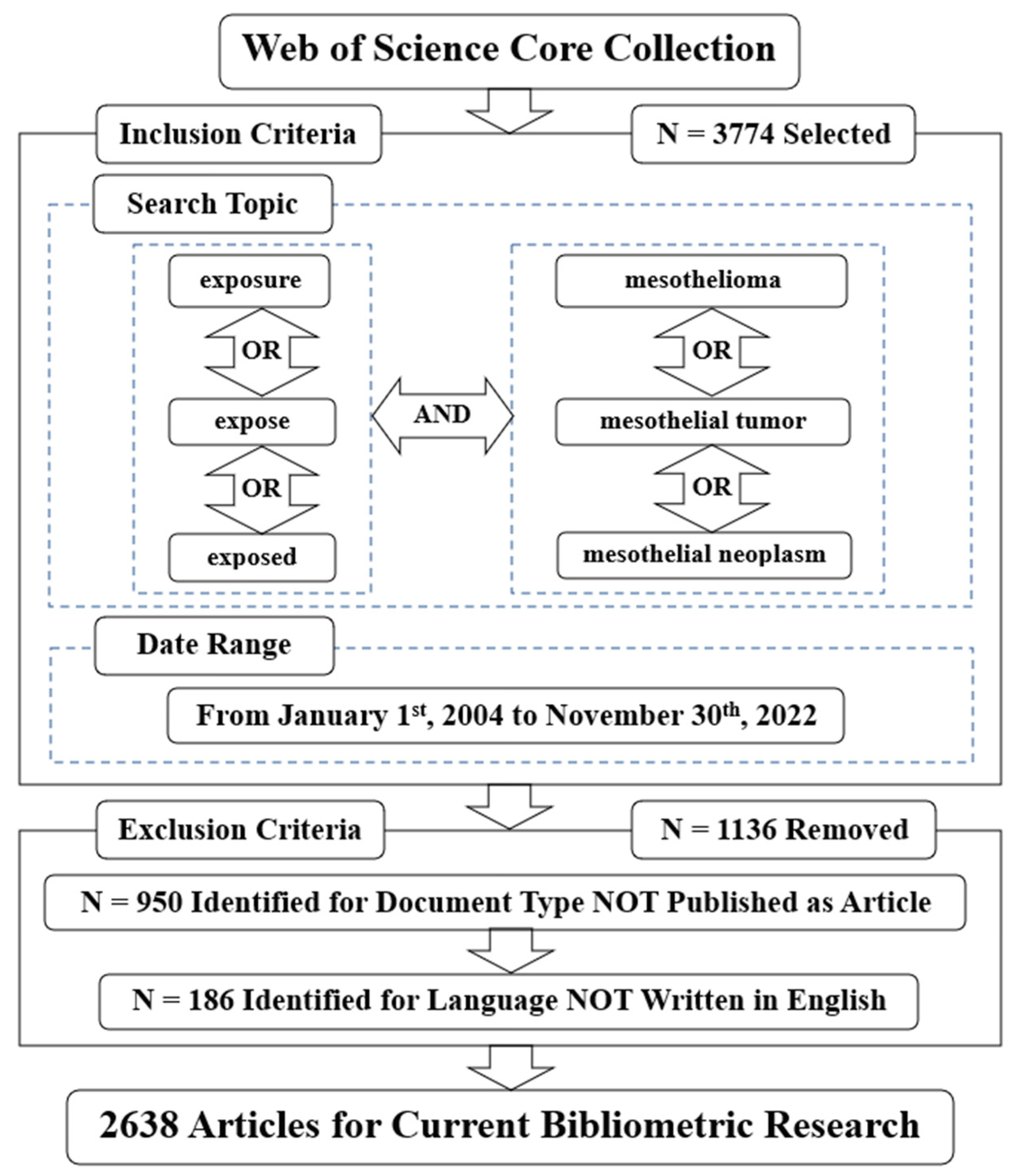
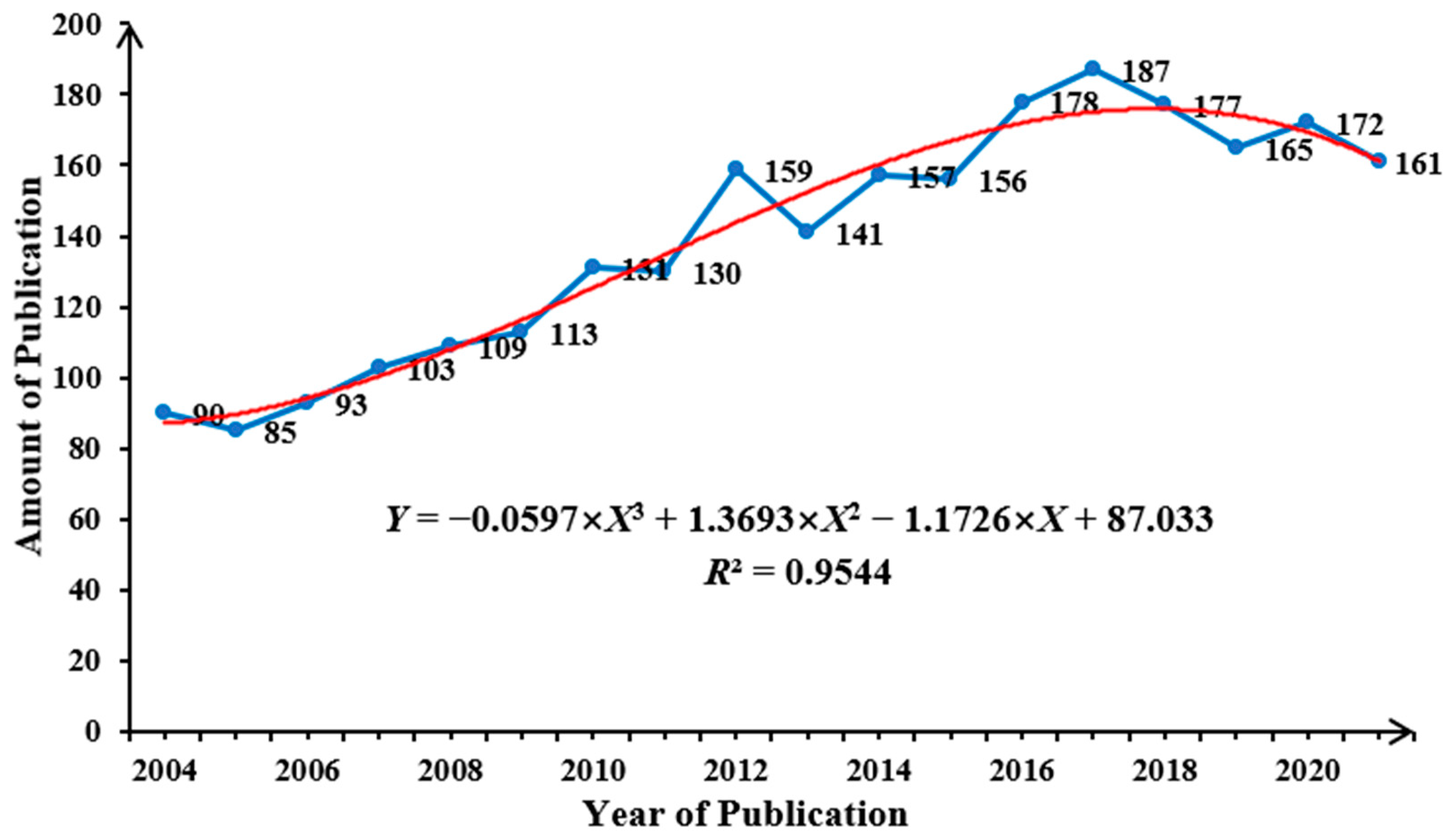

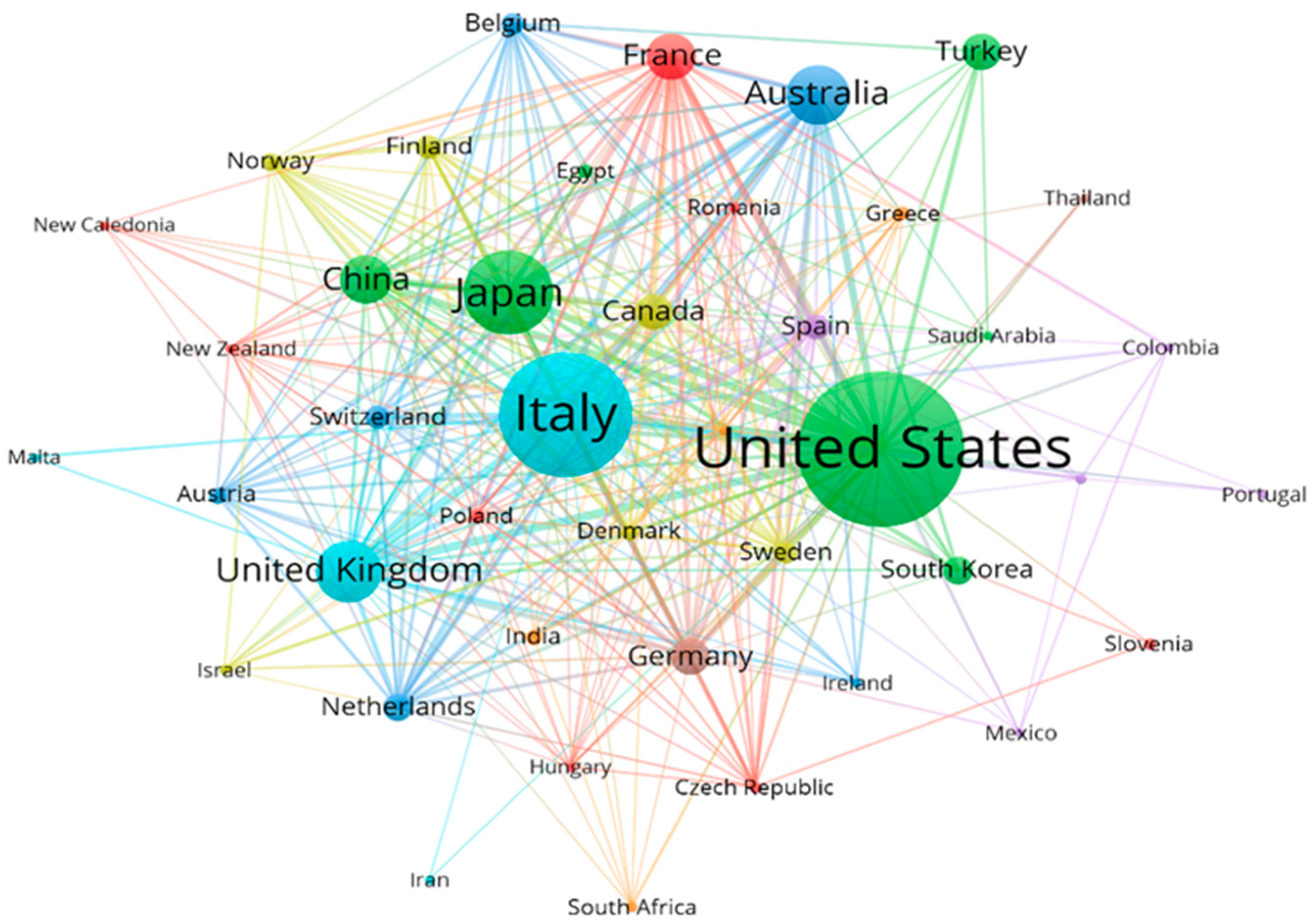
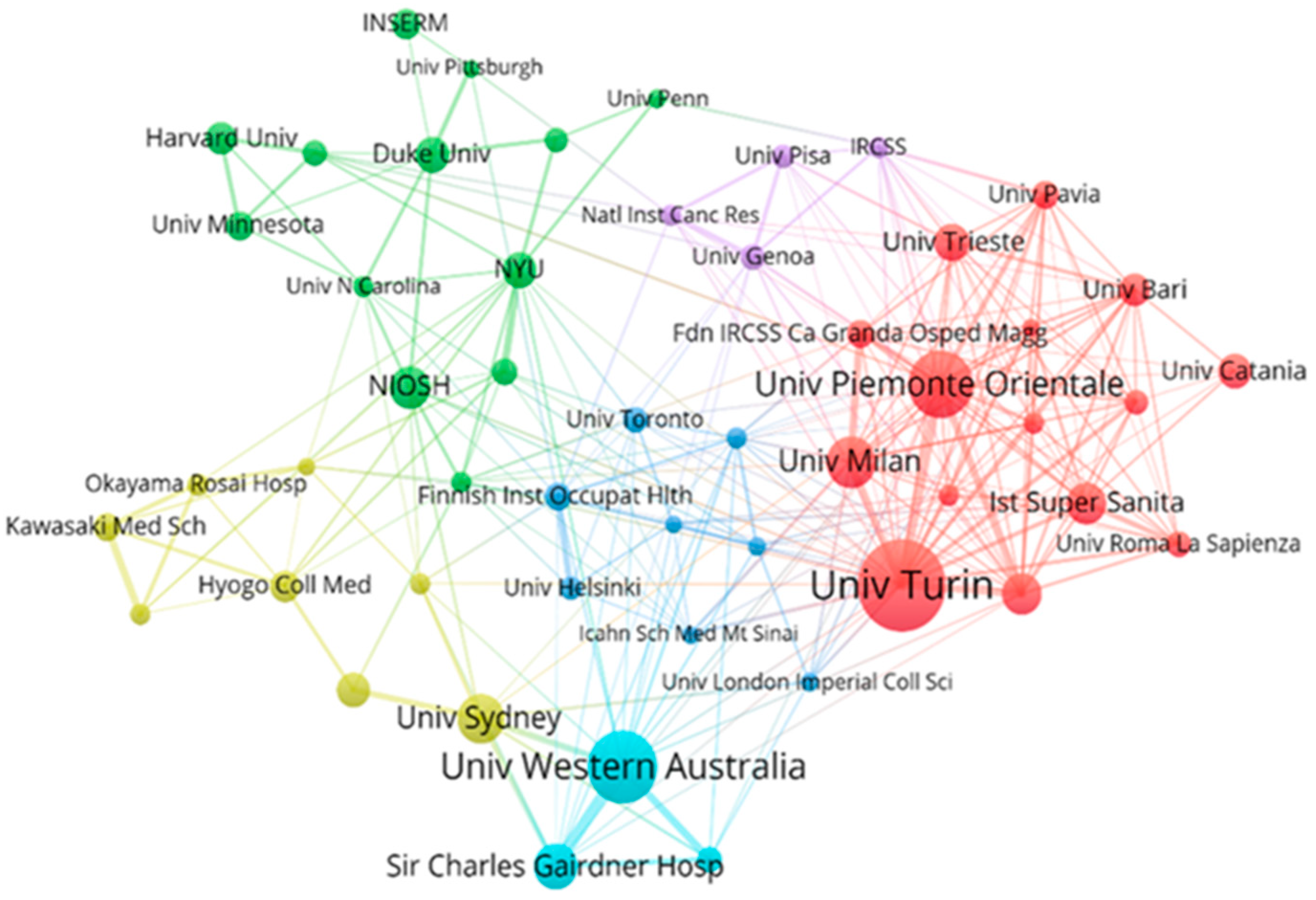

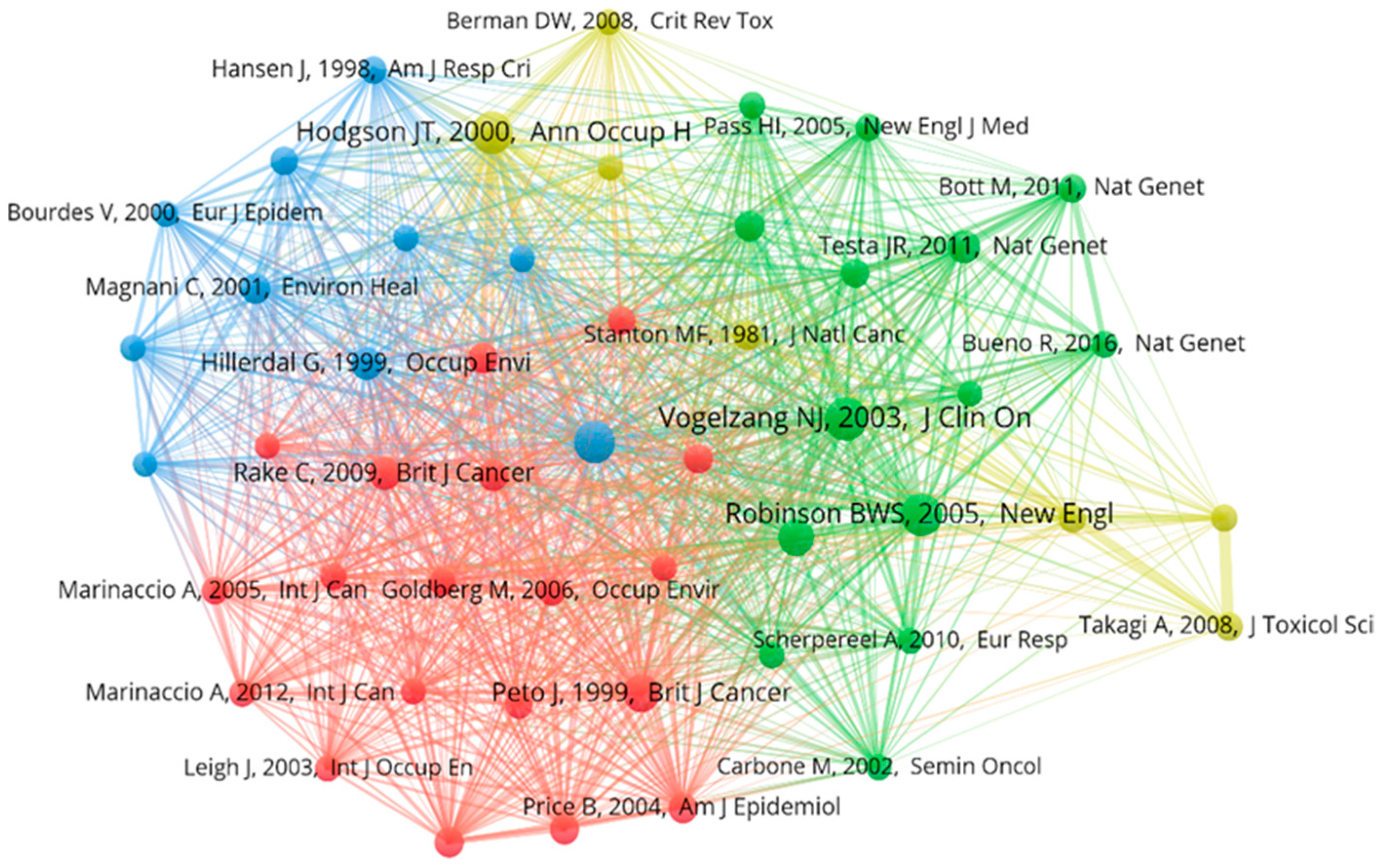
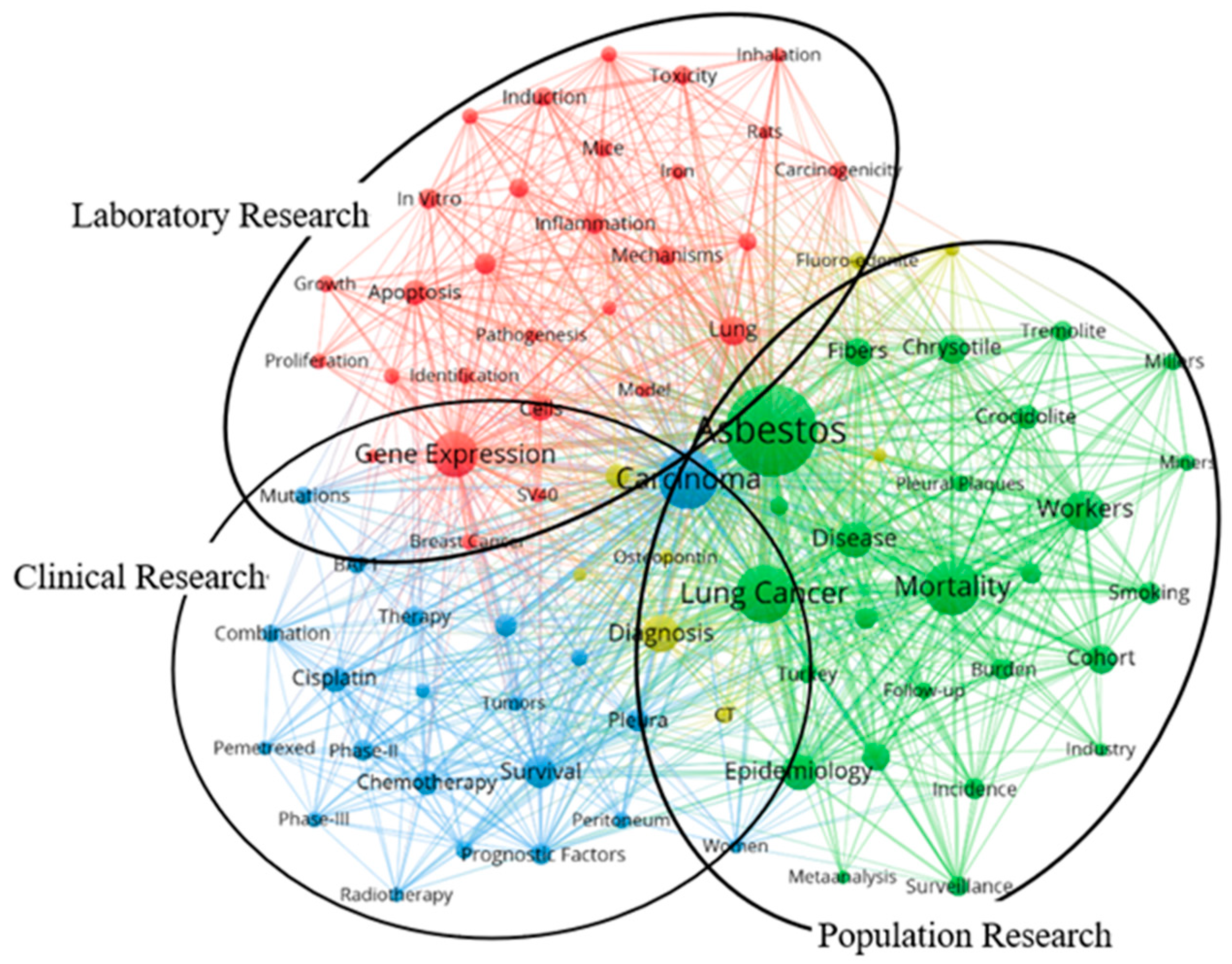

| Institution | Document (%) | Citation | # Country | H-Index |
|---|---|---|---|---|
| University of Turin | 118 (4.47) | 2938 | Italy | 34 |
| University of Western Australia | 85 (3.22) | 2407 | Australia | 30 |
| Amedeo Avogadro University of Eastern Piedmont | 84 (3.18) | 2347 | Italy | 31 |
| * National Institute of Health and Medical Research | 71 (2.69) | 2812 | France | 26 |
| Udice French Research Universities | 66 (2.50) | 2260 | France | 23 |
| Harvard University | 59 (2.24) | 2104 | USA | 26 |
| Centers for Disease Control and Prevention | 55 (2.08) | 2442 | USA | 23 |
| University of Sydney | 52 (1.97) | 1655 | Australia | 23 |
| * Piedmont Reference Center for Epidemiology and Cancer Prevention | 52 (1.97) | 1444 | Italy | 25 |
| University of Milan | 52 (1.97) | 1185 | Italy | 19 |
| University of Genoa | 48 (1.82) | 1778 | Italy | 25 |
| * IRCCS Ca Granda Foundation-Maggiore Policlinico Hospital | 47 (1.78) | 867 | Italy | 15 |
| New York University | 46 (1.74) | 4318 | USA | 31 |
| National Institute for Occupational Safety and Health | 46 (1.74) | 2442 | USA | 20 |
| * National Institute of Health | 46 (1.74) | 855 | Italy | 18 |
| Institution | Document (%) | Citation | # Country | H-Index |
|---|---|---|---|---|
| Department of Health and Human Services | 235 (8.91) | 11,150 | USA | 57 |
| National Institutes of Health | 209 (7.92) | 10,319 | USA | 53 |
| National Cancer Institute | 136 (5.16) | 7647 | USA | 48 |
| Ministry of Education, Culture, Sports, Science, and Technology | 109 (4.13) | 2741 | Japan | 29 |
| Society for the Promotion of Science | 78 (2.96) | 1889 | Japan | 23 |
| National Institute of Environmental Health Sciences | 75 (2.84) | 3013 | USA | 33 |
| European Commission | 63 (2.39) | 3676 | Belgium | 26 |
| Grants-in-Aid for Scientific Research | 60 (2.27) | 1268 | Japan | 19 |
| * AIRC-Foundation for Cancer Research | 52 (1.97) | 2060 | Italy | 26 |
| Ministry of Health, Labour and Welfare | 47 (1.78) | 2226 | Japan | 22 |
| Centers for Disease Control and Prevention | 37 (1.40) | 1192 | USA | 16 |
| National Health and Medical Research Council | 36 (1.36) | 830 | Australia | 18 |
| National Institute for Occupational Safety and Health | 30 (1.14) | 1077 | USA | 14 |
| UK Research and Innovation | 25 (0.95) | 2929 | UK | 16 |
| Medical Research Council | 22 (0.83) | 2895 | UK | 15 |
| Journal | Document (%) | Citation | * IF in 2021 | # Country |
|---|---|---|---|---|
| Occupational and Environmental Medicine | 80 (3.03) | 2925 | 4.948 | UK |
| American Journal of Industrial Medicine | 74 (2.81) | 1269 | 3.079 | USA |
| Lung Cancer | 51 (1.93) | 1264 | 6.081 | Ireland |
| International Journal of Environmental Research and Public Health | 49 (1.86) | 263 | 4.614 | Switzerland |
| Journal of Thoracic Oncology | 36 (1.36) | 1460 | 20.121 | USA |
| Inhalation Toxicology | 32 (1.21) | 489 | 3.011 | UK |
| Journal of Occupational and Environmental Medicine | 31 (1.18) | 430 | 2.306 | USA |
| Regulatory Toxicology and Pharmacology | 28 (1.06) | 492 | 3.598 | USA |
| PLOS One | 27 (1.02) | 837 | 3.752 | USA |
| BMC Cancer | 26 (0.99) | 468 | 4.638 | UK |
| Cancer Research | 22 (0.83) | 1638 | 13.312 | USA |
| Cancers | 22 (0.83) | 118 | 6.575 | Switzerland |
| British Journal of Cancer | 21 (0.80) | 1252 | 9.075 | UK |
| Cancer Science | 21 (0.80) | 534 | 6.518 | USA |
| International Archives of Occupational and Environmental Health | 19 (0.72) | 236 | 2.851 | Germany |
| Author | Document (%) | Citation | Institution | # Country | H-Index |
|---|---|---|---|---|---|
| Corrado Magnani | 52 (1.97) | 1431 | University of Eastern Piedmont Amedeo Avogadro | Italy | 24 |
| Dario Mirabelli | 51 (1.93) | 1704 | University of Turin | Italy | 28 |
| Alessandro Marinaccio | 51 (1.93) | 1145 | * Italian Workers Compensation Authority | Italy | 19 |
| Harvey I. Pass | 48 (1.82) | 4276 | New York University | USA | 33 |
| Michele Carbone | 44 (1.67) | 4472 | University of Hawaii System | USA | 32 |
| Nicholas H. de Klerk | 30 (1.14) | 1016 | University of Western Australia | Australia | 20 |
| Enzo Merler | 29 (1.10) | 1112 | University of Padua | Italy | 19 |
| Alison Reid | 29 (1.10) | 765 | Curtin University | Australia | 15 |
| Pietro Comba | 29 (1.10) | 499 | * National Institute of Health | Italy | 14 |
| Carolina Mensi | 24 (0.91) | 750 | * IRCCS Ca Granda Foundation-Maggiore Policlinico Hospital | Italy | 14 |
| V.L. Roggli | 24 (0.91) | 363 | Duke University | USA | 11 |
| Elisabetta Chellini | 23 (0.87) | 668 | Cancer Prevention and Research Institute | Italy | 13 |
| N. Olsen | 23 (0.87) | 614 | University of Western Australia | Australia | 13 |
| Takumi Kishimoto | 23 (0.87) | 481 | Okayama Rosai Hospital | Japan | 12 |
| Jean-Claude Pairon | 21 (0.80) | 635 | * Paris-Est Creteil Val-de-Marne University | France | 12 |
| Author (Year) | Article | Citation | Journal |
|---|---|---|---|
| CA Poland, et al. (2008) | Carbon Nanotubes Introduced into the Abdominal Cavity of Mice Show Asbestos-like Pathogenicity in a Pilot Study [27] | 1875 | Nature Nanotechnology |
| JR Testa, et al. (2011) | Germline BAP1 Mutations Predispose to Malignant Mesothelioma [28] | 674 | Nature Genetics |
| A. Takagi, et al. (2008) | Induction of Mesothelioma in p53+/− Mouse by Intraperitoneal Application of Multi-wall Carbon Nanotube [29] | 591 | Journal of Toxicological Sciences |
| LB Travis, et al. (2005) | Second Cancers among 40,576 Testicular Cancer Patients: Focus on Long-term Survivors [30] | 590 | Journal of the National Cancer Institute |
| G. Zalcman, et al. (2016) | Bevacizumab for Newly Diagnosed Pleural Mesothelioma in the Mesothelioma Avastin Cisplatin Pemetrexed Study (MAPS): A Randomised, Controlled, Open-Label, Phase 3 Trial [31] | 525 | Lancet |
| P. Vineis, et al. (2014) | Global Cancer Patterns: Causes and Prevention [32] | 367 | Lancet |
| JP Ryman-Rasmussen, et al. (2009) | Inhaled Carbon Nanotubes Reach the Subpleural Tissue in Mice [33] | 315 | Nature Nanotechnology |
| HI Pass, et al. (2005) | Asbestos Exposure, Pleural Mesothelioma, and Serum Osteopontin Levels [34] | 301 | New England Journal of Medicine |
| JT Hodgson, et al. (2005) | The Expected Burden of Mesothelioma Mortality in Great Britain from 2002 to 2050 [35] | 278 | British Journal of Cancer |
| PJ Landrigan, et al. (2004) | Health and Environmental Consequences of the World Trade Center Disaster [36] | 260 | Environmental Health Perspectives |
| M. Pacurari, et al. (2008) | Raw Single-wall Carbon Nanotubes Induce Oxidative Stress and Activate MAPKs, AP-1, NF-kappa B, and Akt in Normal and Malignant Human Mesothelial Cells [37] | 254 | Environmental Health Perspectives |
| SE Mutsaers, et al. (2004) | The Mesothelial Cell [38] | 232 | International Journal of Biochemistry & Cell Biology |
| AH Mokdad, et al. (2017) | Trends and Patterns of Disparities in Cancer Mortality among U.S. Counties, 1980–2014 [39] | 225 | Journal of the American Medical Association |
| M. Guled, et al. (2009) | CDKN2A, NF2, and JUN Are Dysregulated among Other Genes by miRNAs in Malignant Mesothelioma: A miRNA Microarray Analysis [40] | 216 | Genes Chromosomes & Cancer |
| B. Price et al. (2004) | Mesothelioma Trends in the United States: An Update Based on Surveillance, Epidemiology, and End Results Program Data for 1973 Through 2003 [41] | 209 | American Journal of Epidemiology |
Disclaimer/Publisher’s Note: The statements, opinions and data contained in all publications are solely those of the individual author(s) and contributor(s) and not of MDPI and/or the editor(s). MDPI and/or the editor(s) disclaim responsibility for any injury to people or property resulting from any ideas, methods, instructions or products referred to in the content. |
© 2023 by the authors. Licensee MDPI, Basel, Switzerland. This article is an open access article distributed under the terms and conditions of the Creative Commons Attribution (CC BY) license (https://creativecommons.org/licenses/by/4.0/).
Share and Cite
Lai, H.; Hu, C.; Qu, M.; Liu, X.; Xue, Y.; Xu, P.; Hao, D. Mesothelioma Due to Workplace Exposure: A Comprehensive Bibliometric Analysis of Current Situation and Future Trends. Int. J. Environ. Res. Public Health 2023, 20, 2833. https://doi.org/10.3390/ijerph20042833
Lai H, Hu C, Qu M, Liu X, Xue Y, Xu P, Hao D. Mesothelioma Due to Workplace Exposure: A Comprehensive Bibliometric Analysis of Current Situation and Future Trends. International Journal of Environmental Research and Public Health. 2023; 20(4):2833. https://doi.org/10.3390/ijerph20042833
Chicago/Turabian StyleLai, Hanpeng, Chenglei Hu, Man Qu, Xing Liu, Yu Xue, Ping Xu, and Dongdong Hao. 2023. "Mesothelioma Due to Workplace Exposure: A Comprehensive Bibliometric Analysis of Current Situation and Future Trends" International Journal of Environmental Research and Public Health 20, no. 4: 2833. https://doi.org/10.3390/ijerph20042833
APA StyleLai, H., Hu, C., Qu, M., Liu, X., Xue, Y., Xu, P., & Hao, D. (2023). Mesothelioma Due to Workplace Exposure: A Comprehensive Bibliometric Analysis of Current Situation and Future Trends. International Journal of Environmental Research and Public Health, 20(4), 2833. https://doi.org/10.3390/ijerph20042833







